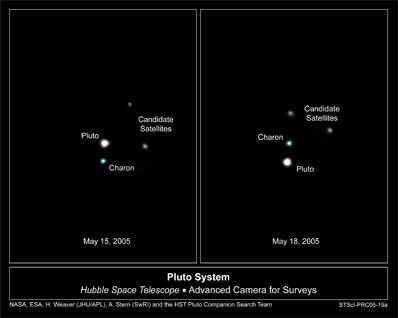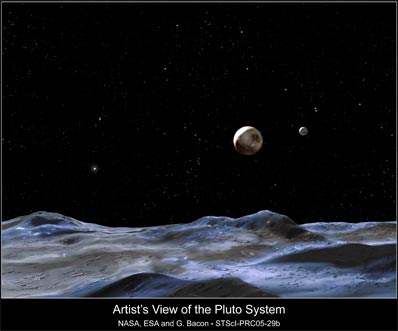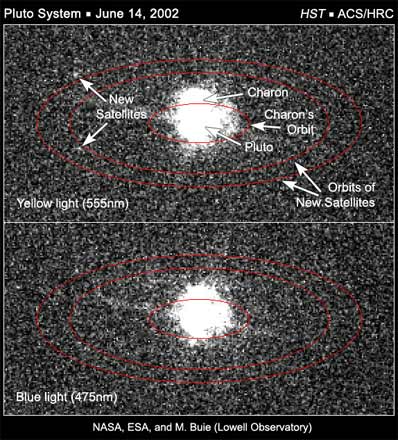
Spaceflight Now +

|

|

|

|

Premium video content for our Spaceflight Now Plus subscribers.

Shuttle engine test
 For the first time since Hurricane Katrina, NASA's Stennis Space Center in Mississippi conducts a test-firing of a space shuttle main engine. The engine was run as part of a certification series on the Advanced Health Management System, which monitors engine performance. For the first time since Hurricane Katrina, NASA's Stennis Space Center in Mississippi conducts a test-firing of a space shuttle main engine. The engine was run as part of a certification series on the Advanced Health Management System, which monitors engine performance.

 Play video Play video

Edwards air show
 Edwards Air Force Base hosted an open house and air show this past weekend. NASA's Dryden Flight Research Center demonstrated some of its specialized aircraft -- a highly modified NF-15B, a high-altitude ER-2, and F/A-18 and T-34. On the ground, a variety of specialized air and space vehicles were on display in the NASA exhibit, ranging from the Mars rovers to the 747 space shuttle carrier aircraft. Edwards Air Force Base hosted an open house and air show this past weekend. NASA's Dryden Flight Research Center demonstrated some of its specialized aircraft -- a highly modified NF-15B, a high-altitude ER-2, and F/A-18 and T-34. On the ground, a variety of specialized air and space vehicles were on display in the NASA exhibit, ranging from the Mars rovers to the 747 space shuttle carrier aircraft.

 Play video Play video

ISS science 'suitcases'
 Scientists eagerly examine suitcase-like packages, called the Materials International Space Station Experiments, or MISSEs, after return to Earth. The MISSE packages were flown outside the orbiting station to expose different materials to the space environments for study. Scientists eagerly examine suitcase-like packages, called the Materials International Space Station Experiments, or MISSEs, after return to Earth. The MISSE packages were flown outside the orbiting station to expose different materials to the space environments for study.

 Play video Play video

Tracking hurricanes
 This 2005 Atlantic hurricane season has a been a record-breaker. Satellite imagery since June 1 has been compiled into this movie to track the 21 named storms as they formed and traveled, many making landfall. This 2005 Atlantic hurricane season has a been a record-breaker. Satellite imagery since June 1 has been compiled into this movie to track the 21 named storms as they formed and traveled, many making landfall.

 Play video Play video

Hurricane Wilma
 International Space Station cameras captured this incredible video of Hurricane Wilma and its well-defined eye from an altitude of 220 miles. Wilma was packing winds of 175 miles an hour as a Category 5 storm when the station flew overhead. International Space Station cameras captured this incredible video of Hurricane Wilma and its well-defined eye from an altitude of 220 miles. Wilma was packing winds of 175 miles an hour as a Category 5 storm when the station flew overhead.

 Play video Play video

Hubble examines moon
 NASA has used the Hubble Space Telescope for scientific observations of the Earth's moon in the search for important oxygen-bearing minerals -- potential resources for human exploration. Scientists held this news conference on October 19 to discuss their investigations. NASA has used the Hubble Space Telescope for scientific observations of the Earth's moon in the search for important oxygen-bearing minerals -- potential resources for human exploration. Scientists held this news conference on October 19 to discuss their investigations.

 Play video Play video

Fuel tank leaves KSC
 Space shuttle external fuel tank No. 120 is moved out of Kennedy Space Center's Vehicle Assembly Building and loaded onto a barge for transport to the Michoud Assembly Facility in New Orleans. Once there, the tank will undergo modifications prior to being returned to Florida for a future launch. Space shuttle external fuel tank No. 120 is moved out of Kennedy Space Center's Vehicle Assembly Building and loaded onto a barge for transport to the Michoud Assembly Facility in New Orleans. Once there, the tank will undergo modifications prior to being returned to Florida for a future launch.

 Play video Play video

Space shuttle update
 Space shuttle program officials Friday held a news conference at the Johnson Space Center to provide a status report on efforts to understand and fix the external tank foam insulation problems and confirm that the next launch won't happen before May 2006. Space shuttle program officials Friday held a news conference at the Johnson Space Center to provide a status report on efforts to understand and fix the external tank foam insulation problems and confirm that the next launch won't happen before May 2006.

 Dial-up | Broadband Dial-up | Broadband

 Become a subscriber Become a subscriber
 More video More video

|

|

|

|
|

|

Hubble reveals possible new moons orbiting around Pluto
NASA NEWS RELEASE
Posted: October 31, 2005
Using NASA's Hubble Space Telescope to probe the ninth planet in our solar system,
astronomers discovered that Pluto may have not one, but three moons.
If confirmed, the discovery of the two new moons could offer insights into the nature and
evolution of the Pluto system, Kuiper Belt Objects with satellite systems, and the early
Kuiper Belt. The Kuiper Belt is a vast region of icy, rocky bodies beyond Neptune's orbit.

These Hubble images reveal Pluto, its large moon Charon, and the planet's two new candidate satellites. Between May 15 and May 18, 2005, Charon, and the putative moons, provisionally designated P1 and P2, all appear to rotate counterclockwise around Pluto. P1 and P2 are thousands of times less bright than Pluto and Charon. The enhanced-color images of Pluto and Charon were constructed by combining short exposure images taken in filters near 475 nanometers (blue) and 555 nanometers (green-yellow). The images of the new satellites were made from longer exposures taken in a single filter centered near 606 nanometers (yellow), so no color information is available for them. Credit: NASA, ESA, H. Weaver (JHU/APL), A. Stern (SwRI), and the Hubble Space Telescope Pluto Companion Search Team
Download larger image version here
|
"If, as our new Hubble images indicate, Pluto has not one, but two or three moons, it will
become the first body in the Kuiper Belt known to have more than one satellite," said Hal
Weaver of the Johns Hopkins Applied Physics Laboratory, Laurel, Md. He is co-leader of the
team that made the discovery.
Pluto was discovered in 1930. Charon, Pluto's only confirmed moon, was discovered by
ground-based observers in 1978. The planet resides 3 billion miles from the sun in the heart
of the Kuiper Belt.
"Our result suggests that other bodies in the Kuiper Belt may have more than one moon. It
also means that planetary scientists will have to take these new moons into account when
modeling the formation of the Pluto system," said Alan Stern of the Southwest Research
Institute in Boulder, Colo. Stern is co-leader of the research team.
The candidate moons, provisionally designated S/2005 P1 and S/2005 P2, were observed to be
approximately 27,000 miles (44,000 kilometers) away from Pluto. The objects are roughly two
to three times as far from Pluto as Charon.

This illustration shows the Pluto system from the surface of one of the candidate moons. The other members of the Pluto system are just above the putative moon's surface. Pluto is the large disk at center, right. Charon, the system's only confirmed moon, is the smaller disk to the right of Pluto. The other candidate moon is the bright dot on Pluto's far left. Credit: NASA, ESA and G. Bacon (STScI)
Download larger image version here
|
The team plans to make follow-up Hubble observations in February to confirm that the newly
discovered objects are truly Pluto's moons. Only after confirmation will the International
Astronomical Union consider names for S/2005 P1 and S/2005 P2.
The Hubble telescope's Advanced Camera for Surveys observed the two new candidate moons on
May 15, 2005. "The new satellite candidates are roughly 5,000 times fainter than Pluto, but
they really stood out in these Hubble images," said Max Mutchler of the Space Telescope
Science Institute and the first team member to identify the satellites. Three days later,
Hubble looked at Pluto again. The two objects were still there and appeared to be moving in
orbit around Pluto.
"A re-examination of Hubble images taken on June 14, 2002 has essentially confirmed the
presence of both P1 and P2 near the predicted locations based on the 2005 Hubble
observations," said Marc Buie of Lowell Observatory, Flagstaff, Ariz., another member of
the research team.

Hubble images taken with the ACS/HRC on June 14th, 2002, reveals two objects that are consistent with the expected locations of the newly-discovered satellites. One image (top) was taken in yellow light (555 nm) and the other (bottom) was taken in blue light (475 nm). The ellipse shows the orbital path of the new satellites derived from the May 2005 Hubble observations. The satellites should lie somewhere along this ellipse and, indeed, there are two objects along the predicted path, thus confirming the 2005 observations. Credit: NASA, ESA, and M. Buie (Lowell Observatory)
Download larger image version here
|
The team looked long and hard for other potential moons around Pluto. "These Hubble images
represent the most sensitive search yet for objects around Pluto," said team member Andrew
Steffl of the Southwest Research Institute, "and it is unlikely that there are any other
moons larger than about 10 miles across in the Pluto system."
The Hubble Space Telescope is a project of international cooperation between NASA and the
European Space Agency. The Space Telescope Science Institute in Baltimore conducts Hubble
science operations. The Institute is operated for NASA by the Association of Universities
for Research in Astronomy, Inc., Washington, under contract with Goddard.
The other team members for this observation are: William J. Merline, John R. Spencer, Eliot Y. Young, and Leslie A. Young, Southwest Research Institute.
|

|

|

|


|



